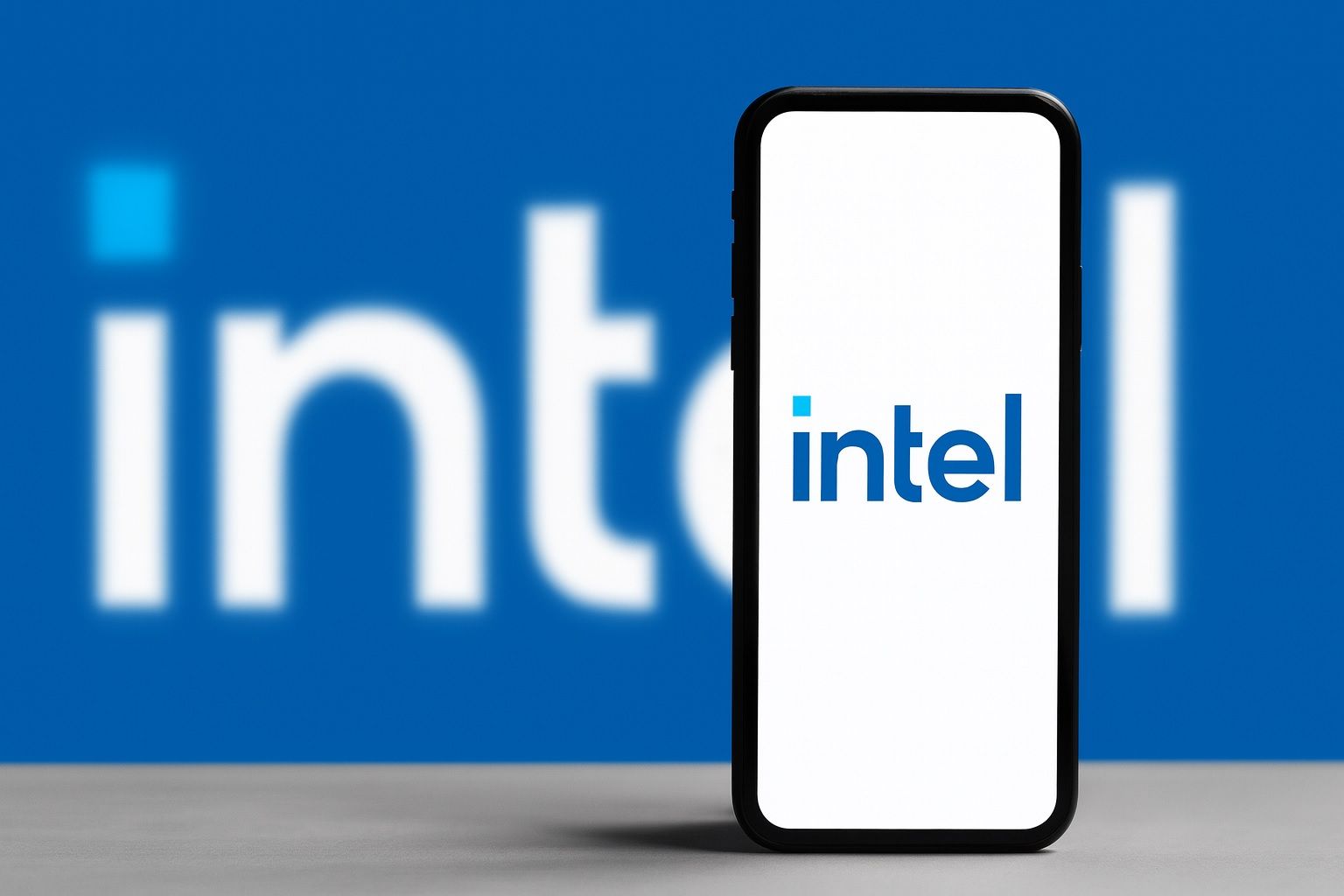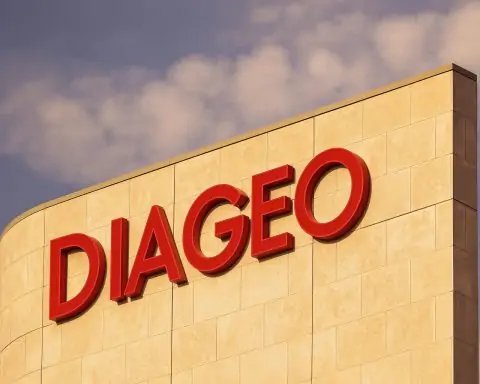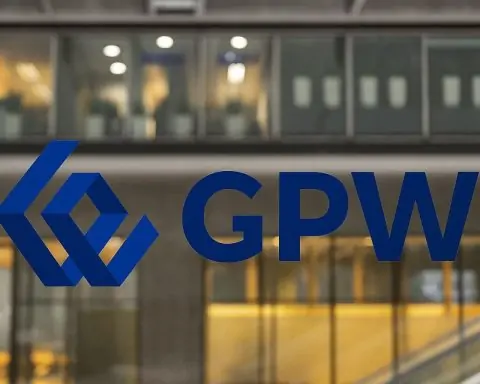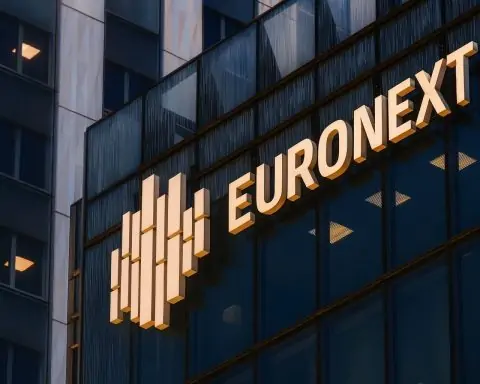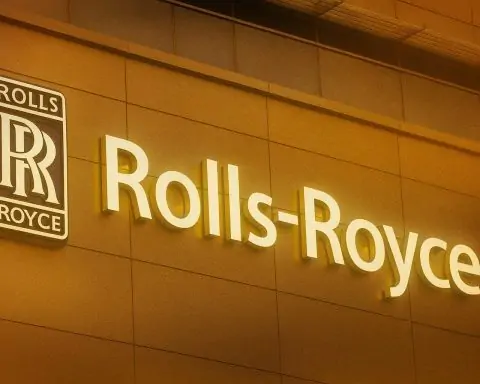- Q3 comeback: Intel returned to profitability in Q3 2025, reporting revenue of $13.7 billion (up ~3% YoY) and adjusted earnings of $0.23 per share – handily beating Wall Street’s breakeven expectations [1] [2]. CEO Lip-Bu Tan hailed “steady progress,” noting that “AI is accelerating demand” across Intel’s processor and chip businesses [3].
- Shares surge:Intel stock (NASDAQ: INTC) has soared ~90% year-to-date in 2025, vastly outperforming rival chipmakers [4]. After the Q3 beat, shares jumped ~8% in after-hours trading to around $37–$38 [5], and by Oct. 29, 2025, Intel stock was trading near a two-year high in the low-$40s. Investors cheered signs of a turnaround, with one analyst noting Intel’s stock “popped” on better-than-feared guidance, cost improvements, “AI-PC buzz,” and a $15 billion strategic funding boost [6].
- $15 billion lifeline: In recent months, Intel secured unprecedented backing to bolster its finances. The U.S. government took a ~9.9% stake for $8.9 billion, while NVIDIA invested $5 billion for ~4% and SoftBank added $2 billion [7]. These blockbuster deals have infused Intel with cash and credibility, providing a vital lifeline after a dismal 2024 [8] [9]. Intel’s share price, which plunged ~60% last year, has rebounded sharply on hopes that the funding and partnerships will accelerate its turnaround [10].
- AI and chips push: Intel is racing to reclaim ground in artificial intelligence (AI) and cutting-edge chips. It just announced a new AI data-center GPU (code-named “Crescent Island”) launching in 2024 as its “latest attempt to capitalize on the frenzy in AI” after lagging Nvidia [11]. The chip will focus on efficient AI inference performance [12]. Meanwhile, Intel’s next-gen “Panther Lake” PC processors – its first built on the advanced 18A process node – are on track to ship by late 2025 [13], tapping into a PC upgrade cycle that lifted Q3 PC chip revenue by an estimated 11% [14].
- Turnaround efforts: Since taking over in early 2025, CEO Tan Lip-Bu has aggressively cut costs (workforce down >20% this year) and scaled back the costly manufacturing expansion of his predecessor [15]. Tan formed a new engineering unit to streamline chip design and even offer custom chips to outside clients [16]. He also sold a majority stake in Intel’s Altera FPGA unit to raise cash [17]. These moves, along with the strategic investments, have “offered a lifeline to the stock” and put Intel on more solid footing [18].
- Competitive landscape: Intel’s comeback comes amid a broader semiconductor boom driven by AI. Global chip sales are on track for a record ~$697 billion in 2025 [19]. Rivals are thriving: AMD’s stock hit an all-time high (~$240) and is up ~80% this year, as it gains CPU market share and secures big AI chip wins [20]. NVIDIA – the AI chip leader – has seen its value skyrocket to ~$5 trillion [21] [22], dominating ~90% of the data-center AI processor market [23]. By contrast, Intel’s market capitalization (~$175 billion) is only about half of AMD’s and a small fraction of Nvidia’s [24], reflecting the ground Intel still needs to recover.
- Analyst reaction: Reactions on Wall Street are mixed. Some experts see legitimate progress – “Intel has turned a corner and is steadying the ship… it feels like a strong setup for 2026,” said Creative Strategies CEO Ben Bajarin [25]. However, many remain cautious. The average 12-month price target is only ~$29 (well below the current stock price), and most brokers rate Intel a “Hold” or worse [26]. Bank of America recently cut its rating to Underperform, warning shares have run “too far, too fast” relative to Intel’s still-limited earnings power [27]. Bernstein analysts likewise urged restraint, saying “this fight is far from over – perhaps it’s better to call it a draw for now” [28].
Q3 2025 Earnings Fuel Stock Rebound
Intel’s third-quarter 2025 results provided the clearest evidence yet that the beleaguered chip giant’s turnaround plan is gaining traction. The company swung back to profit in Q3, reporting $13.7 billion in revenue and $0.23 in adjusted EPS – a surprise upside compared to analyst forecasts of roughly breakeven [29]. It marked a dramatic improvement from the year-ago period, when Intel was deep in the red (Q3 2024 saw a massive $16 billion net loss) [30]. Gross margins also rebounded to 40% (vs ~36% expected), reflecting the impact of steep cost cuts and operational efficiencies [31].
Wall Street greeted the results with relief. Intel’s stock jumped about 7–8% in after-hours trading on Oct. 23 following the earnings release [32]. That pop lifted INTC into the high $30s per share, territory it had not seen in roughly two years [33]. While shares gave back some gains in the ensuing days, they continued to grind higher, and by the morning of Oct. 29 the stock was hovering around $42 – roughly double its level at the start of 2025. Overall, Intel’s market value has nearly doubled in 2025 (≈+90%), handily outpacing not just the S&P 500 but also industry peers like Nvidia and AMD [34]. This marks a stunning reversal from 2022–2023, when Intel’s stock collapsed on repeated misses and an ill-fated expansion drive.
Investors are betting on a comeback, and the Q3 beat reinforced that optimism. Intel’s PC chip division showed fresh momentum, buoyed by a revival in PC demand (global PC shipments rose ~8% in Q3 after a long slump) [35] [36]. The company’s Client Computing Group revenue was estimated to jump ~11% year-over-year, aided by the ramp-up of Intel’s new “Panther Lake” processors – the first PC chips built on the Intel 18A process, slated to begin shipping by late 2025 [37]. On the data center side, Intel’s Data Center and AI group also returned to growth, with analysts projecting ~18% revenue growth to $3.95 billion [38] as enterprise and cloud customers upgraded to newer CPUs. Notably, Intel’s finance chief David Zinsner said demand is now outstripping supply for many Intel chips – especially as data-center operators realize they must refresh CPUs to support power-hungry AI accelerators [39]. “We’re under-shipping demand at this point, which I guess is a high-class problem,” Zinsner quipped [40], indicating Intel could have sold even more chips if it had additional capacity.
The strong quarter was a proof point for CEO Lip-Bu Tan’s turnaround efforts. Tan, who took the helm in early 2025, has instituted dramatic changes after Intel’s multi-year slump. He slashed expenses, implemented layoffs (>20% of staff cut) [41], and unwound some of the grand expansion plans of former CEO Pat Gelsinger (whose strategy had led Intel to its first annual loss since 1986 last year) [42]. Those painful moves helped stabilize Intel’s finances. As a result, Q3 2025 broke a six-quarter streak of either losses or shrinking sales [43]. “Intel’s cost-cutting boosts finances amid major investments,” Reuters noted, as Tan’s discipline starts to pay off [44].
Crucially, Intel’s guidance suggests the improvement can continue. For Q4 2025, the company forecast revenue of $12.8–13.8 billion (midpoint ~$13.3B) – essentially in line with analysts’ expectations [45]. It expects a small non-GAAP profit (~$0.08 EPS) [46]. While hardly spectacular, that outlook indicates stability and an end to the steep revenue declines of 2022–2023. Tan struck an optimistic tone, saying the underlying demand trends remain strong in both PCs and servers thanks to AI. He highlighted an ongoing “AI-driven refresh cycle”: PC buyers upgrading to AI-optimized Windows 11 machines, and cloud providers equipping data centers with new CPUs to complement GPU accelerators [47]. In short, Intel expects the current AI boom to keep lifting demand for its x86 processors, accelerators, and even its foundry services [48].
$15 Billion AI Deals Provide Lifeline
Intel’s nascent rebound has been bolstered – and arguably made possible – by a series of extraordinary strategic investments unveiled in recent months. In what observers have called a “flurry of high-stakes bets on future growth,” Intel secured roughly $15 billion in new funding from deep-pocketed allies [49] [50]. These deals, all announced during Q3, sent a strong signal of confidence in Intel’s technology roadmap at a critical moment.
- U.S. Government stake: In August, the U.S. government agreed to take a ~10% equity stake in Intel for $8.9 billion [51]. This unprecedented move – converting federal CHIPS Act subsidies into a stock investment – was driven by Washington’s desire to shore up domestic chipmaking and reduce reliance on Asian foundries. It came after President Donald Trump personally pressured Intel, even calling for CEO Tan’s resignation over Intel’s past ties to China [52]. Tan met with Trump and outlined his plan to refocus Intel, which helped convince the White House to back Intel as a national champion [53] [54]. “I told him the plan… he was delighted,” Tan said of Trump, comparing the U.S. support to how Taiwan supports TSMC [55]. The $8.9B government lifeline, using unused CHIPS Act funds, gives Intel a much-needed cash infusion and political tailwind.
- NVIDIA partnership: In September, Nvidia – the world’s most valuable semiconductor company – announced a $5 billion investment in Intel for a ~4% stake [56]. The two companies also agreed to jointly develop new chips for PCs and data centers [57]. This was a stunning alliance: Nvidia is the leader in AI accelerators, a market Intel has struggled to crack, and had long been more of a rival. Nvidia’s CEO Jensen Huang effectively placed a bet on Intel’s resurgence (perhaps hedging against Nvidia’s own reliance on third-party fabs). The news electrified investors – Intel’s shares surged ~23% in one day on Sept. 18 when the Nvidia deal was unveiled [58] [59]. Analysts say the partnership could “help [Intel] make up some ground in AI” and might even open the door for Intel to manufacture chips for Nvidia in the future, posing a longer-term threat to foundry leader TSMC [60] [61]. (Notably, the current deal does not involve Intel making Nvidia’s chips – Nvidia continues to rely on TSMC – but down the road, if Intel’s manufacturing improves, that could change.) For now, Nvidia’s cash and vote of confidence have buoyed Intel’s credibility in the AI arena.
- SoftBank Vision Fund: Rounding out the trio, Japan’s SoftBank (via its Vision Fund) invested $2 billion for a small stake in Intel during Q3 [62]. This was reportedly tied to certain assets or partnerships (SoftBank is a major tech investor, and one of its portfolio companies, Arm, is a strategic player in chips). While smaller in scale, SoftBank’s backing added another external validation of Intel’s prospects. Intel received the $2B from SoftBank in Q3, though Nvidia’s $5B had not yet closed by quarter’s end [63] [64].
Together, these investments are an “extraordinary lifeline” for Intel [65]. The company’s balance sheet was under strain after the losses of 2022–24 and heavy capital spending. CFO Zinsner confirmed that Intel has taken “meaningful steps…to strengthen our balance sheet,” directly citing the infusion of cash from the U.S., Nvidia and SoftBank [66]. The $15B war chest enables Intel to keep funding its manufacturing and R&D ambitions. In fact, Intel now plans to boost its capital expenditures to $27 billion in 2025 (up from $17B in 2024) to accelerate development of new process technologies and fabs [67]. Crucially, the deals also shored up market confidence in Intel’s future. “These investments, along with Tan’s turnaround efforts, have offered a lifeline to the stock,” noted Reuters [68]. By late October, Intel’s stock had rebounded ~90% YTD, “outperforming AI chip leaders Nvidia and AMD” thanks in large part to optimism around the strategic backing [69].
Beyond the money, Intel is hoping to leverage the partnerships for technological and commercial advantage. For example, Nvidia’s stake comes with a plan to co-develop future chips combining Intel’s CPUs and Nvidia’s GPUs [70]. This could ensure that next-gen PCs and servers pair Nvidia’s AI accelerators seamlessly with Intel processors – a shot at reclaiming share from AMD in high-end systems. It’s essentially an alliance against a common rival: “For Nvidia, AMD is a competitor, so it is pulling Intel in to fight against AMD,” observed one analyst of the deal [71]. Likewise, the U.S. government’s involvement may steer lucrative federal contracts Intel’s way (e.g. foundry orders for defense chips or subsidies for new fab construction). Tan even hinted at “rumors of more” deals, including potential foundry customers or big cloud orders [72]. There is speculation that Microsoft might commit to buying chips from Intel’s foundry or that Apple could return as a client for certain chips [73] [74] – though neither is confirmed.
In short, the strategic investments have dramatically altered Intel’s trajectory. Six months ago, the company’s future was in doubt; today, flush with $15 billion in fresh capital and new marquee partners, Intel has bought itself time and resources to execute its turnaround. As one market strategist summed up, “investors are betting this string of deals is starting to pay off.” [75]
New Chips, AI Ambitions and Foundry Plans
A major focus for Intel now is translating the funding and cost cuts into technology wins – especially in AI and advanced chip manufacturing, where the company fell behind. Intel has taken several steps in recent days to signal it is serious about catching up:
- AI chip “Crescent Island”: On Oct. 14, Intel unveiled a new AI-focused GPU, code-named Crescent Island, aimed at data centers and cloud providers [76]. This graphics processor is designed for AI workloads like machine learning inference – essentially Intel’s latest attempt to break into a booming market dominated by Nvidia’s GPUs. Intel’s CTO Sachin Katti introduced the chip at an industry conference, emphasizing that it is optimized for AI inference with strong performance-per-dollar and power efficiency [77]. “It’s optimized for delivering the best token economics out there,” Katti said, alluding to its ability to process AI model “tokens” (e.g. language model data) cheaply [78]. The Crescent Island GPU will launch in 2024 and is based on Intel’s Arc graphics architecture, repurposed for server use [79]. However, it notably uses a slower type of memory (not the high-bandwidth HBM used by Nvidia and AMD’s top AI chips) [80], indicating it will target cost-efficient inference more than cutting-edge training. Intel’s CEO Tan has vowed to restart Intel’s stalled AI efforts – after the company had previously shelved AI chip projects like its Gaudi accelerators and Falcon Shores – and Crescent Island is a key first step [81]. Going forward, Intel promised to release new data center AI chips every year, matching the cadence of Nvidia and AMD, as it strives to become a viable second source for AI hardware [82].
- PC and server chips: Intel is also pushing ahead with its core CPU roadmap. “Panther Lake”, slated to be Intel’s next major PC processor generation, is now in production. Importantly, Panther Lake is the first chip built on Intel’s 18A process node (roughly equivalent to 1.8 nm class, a next-gen fabrication technology) [83]. Intel managed to start ramping 18A a bit ahead of schedule, and the initial Panther Lake chips are expected to ship before the end of 2025 [84]. This is a milestone: 18A is critical to Intel’s attempt to regain process leadership by 2025–2026. Strong demand for the new chips is anticipated as part of a PC refresh cycle driven by Windows 11. On the server side, Intel’s latest Xeon processors (Sapphire Rapids and Emerald Rapids lines) are seeing uptake as data centers upgrade to support AI workloads. While Intel’s server CPUs don’t directly power AI models (GPUs do that), the surge in AI data centers indirectly helps Intel – “the rapid build-out of data center capacity has expanded the market for its server CPUs used alongside GPUs,” Reuters noted [85]. In other words, every Nvidia GPU cluster still needs a bunch of Intel (or AMD) CPUs to coordinate tasks, and as hyperscalers deploy more AI racks, they often buy newer CPUs too. Intel said it expects robust data-center CPU demand to continue into 2026 thanks to AI [86].
- Foundry business: Under former CEO Gelsinger, Intel had aimed to become a major contract chip manufacturer (foundry) to rival TSMC, investing heavily in new fabs. Tan has pared back these ambitions to be more realistic [87]. Intel did create a standalone foundry division (IFS) and has a few initial customers (like the U.S. Department of Defense and some smaller chip designers). In Q3 2025, Intel’s “Manufacturing Services” segment (essentially the foundry unit plus custom chip revenue) was roughly flat at ~$4.3 billion [88], indicating it’s still a small part of the business. Going forward, Intel’s strategy is to focus its manufacturing on chips where it has an edge and seek external commitments (pre-payments, partnerships) to de-risk fab investments [89]. Notably, Intel’s new U.S. government stake came with expectations that Intel will produce secure chips onshore. And the Nvidia partnership raised the possibility that down the line Nvidia might outsource some chip production to Intel, if Intel can prove its process tech is up to par [90] [91]. Analysts say this could pose a long-term threat to TSMC, which today builds most of Nvidia’s and AMD’s advanced chips [92] [93]. However, Intel faces a steep climb – it is still multiple generations behind TSMC in manufacturing readiness. In fact, Intel acknowledged that yields on its cutting-edge 18A node remain below industry standards and won’t reach “acceptable levels” until 2027 [94]. This means it may take two more years for Intel’s 18A process to become cost-effective and reliable at high volume. “Intel needs to catch up to TSMC in terms of manufacturing capabilities,” one industry expert cautioned, adding that for now “whatever Nvidia develops, it still has to go to TSMC or hopefully in the future, Samsung [foundry]” [95]. Simply put, Intel’s foundry dream is alive but will require patience. On the positive side, Tan’s restructuring and the infusion of capital give Intel some breathing room to improve its processes. And if Intel can convince even one big customer (say, Apple or a major cloud provider) to use its fabs in coming years, that would validate the foundry model. Intel hinted such discussions are underway [96], but no deals have been confirmed.
CEO Lip-Bu Tan has repeatedly stressed that Intel’s new focus is on engineering excellence – building competitive products on schedule – after years of execution missteps. “I decided to come in and clean up,” said Tan, a veteran tech investor who took over in March 2025 [97] [98]. He noted Intel had “too many layers of management” and had grown complacent, leading to its technological slide [99] [100]. Tan has refocused the company on its core strengths: AI, core processors, and its fledgling foundry business [101]. The early results of this refocus are now showing in the Q3 numbers and product pipeline. But the CEO admits Intel still has “a great deal of leeway” from investors to prove itself, and that patience could run out if the company fails to execute [102] [103]. The pressure is on for Intel’s engineers to deliver: launch new chips on time, fix the 18A process, and develop AI accelerators that can at least carve out a niche alongside Nvidia. Intel’s roadmap for 2026–2027 includes successive PC and server CPU updates, a next-gen 18A-based server chip, and more GPUs – all of which will test whether the historic giant can truly reinvent itself for the AI era.
Showdown with AMD, Nvidia, and TSMC
Intel’s fortunes can’t be viewed in isolation – they’re playing out in direct competition with other semiconductor heavyweights. Here’s how Intel stacks up against its key rivals and what recent events mean in those rivalries:
- Advanced Micro Devices (AMD): Long Intel’s chief CPU competitor, AMD has been chipping away at Intel’s market share in both PCs and servers. Over the past few years, AMD’s Ryzen PC chips and EPYC server processors (built by TSMC) won over customers with strong performance and efficiency, at times when Intel struggled with delays. Intel’s Q3 report suggests it may finally be stemming the bleeding – thanks to the PC rebound and new products – but Intel still “has been consistently losing share” to AMD in core processor markets, according to Reuters [104]. Notably, AMD is also riding the AI wave now: its latest MI300 accelerator chips have started securing wins in AI supercomputers, and investors have bid up AMD’s stock accordingly (it hit a record ~$243, +90% YTD around the same time as Intel’s earnings) [105]. The irony is that Intel’s stock rally actually outpaced AMD’s in 2025 (90% vs 80%), but that comes after a far deeper prior slump [106]. In absolute size, AMD’s market cap (~$350B at recent highs) is roughly double Intel’s (~$170B) [107]. AMD’s CEO Lisa Su has kept a steady stream of product launches, and the company is set to report its own Q3 results on Nov. 4. Analysts expect strong growth for AMD, so Intel will face a continued fight to regain lost ground. One bright spot: if Intel’s partnership with Nvidia leads to any preference for Intel CPUs in AI systems (to counter AMD’s CPUs or GPUs), that could dent AMD’s prospects. Indeed, some analysts see Nvidia’s backing of Intel as a blow to AMD – “the biggest victim will be AMD…Nvidia is essentially pulling Intel in to fight AMD,” said a senior Digitimes analyst [108]. AMD for its part has said it will “keep driving market share growth” with an AI-forward strategy [109]. For investors, the Intel vs. AMD battle will be a key subplot in 2026: can Intel’s new chips win back share, or will AMD’s momentum continue?
- Nvidia: In the AI acceleration realm, Nvidia is in a league of its own – and Intel’s relationship with Nvidia is now surprisingly multifaceted (part rival, part partner, part shareholder). Nvidia’s GPUs power an estimated 80–90% of all AI workloads globally [110], making it the indispensable supplier for everything from ChatGPT-like models to autonomous driving systems. This dominance has translated into jaw-dropping financials and market value: Nvidia’s revenues and profit have soared in 2023–25, and in late October 2025 its stock nearly hit a $5 trillion valuation – a milestone no company had reached before [111]. (For perspective, that’s about 25 times Intel’s valuation.) Jensen Huang, Nvidia’s CEO, announced that customers have placed $500 billion worth of orders for Nvidia’s AI chips over the next several years [112] – an almost unfathomable backlog that underscores Nvidia’s central role in the AI boom. Intel simply cannot directly compete with Nvidia’s high-end AI chips at the moment; its strategy instead is to be the best supporting player (providing the CPUs, chip platforms, and some lower-end AI chips to complement Nvidia). The $5B Nvidia investment in Intel suggests Huang wants Intel to stick around and improve – possibly to ensure diversity in the ecosystem and to have a friend in Washington. Nvidia itself is under U.S. government scrutiny (export curbs on advanced chips to China, etc.), and Huang has been carefully balancing relationships in DC and Beijing [113] [114]. Trump is even expected to discuss Nvidia’s latest AI chip with China’s President Xi in upcoming talks [115] [116], showing how Nvidia is now a geopolitical chess piece. From Intel’s view, partnering with Nvidia gives it a stake in the AI gold rush rather than being left entirely on the sidelines. If Intel can co-develop PC or server chips that leverage Nvidia’s AI IP, it could produce unique offerings (for example, an Intel CPU with built-in Nvidia AI acceleration). Still, Intel will likely remain a junior partner – Nvidia’s clout and resources dwarf Intel’s in the AI sphere. In summary, Intel’s turnaround does not threaten Nvidia’s supremacy anytime soon, but the two companies now have aligned interests in some areas. Investors will watch if this partnership bears fruit (joint products or foundry deals) or if it encounters friction.
- Taiwan Semiconductor (TSMC): TSMC is the world’s top chip foundry – it builds chips for fabless companies including Apple, AMD, and Nvidia – and it has been the principal adversary of Intel on the manufacturing front. Intel’s prior CEO wagered billions trying to beat TSMC at its own game (even planning to produce chips for others like Qualcomm and Amazon), but that strategy faltered as Intel hit process delays. Under Tan, Intel’s stance toward TSMC is a bit different: Intel still aims to catch up in process technology (the 18A node is intended to be competitive with TSMC’s 2nm by ~2025-26), but Intel is also pragmatically using TSMC for some chip production in the interim (for example, parts of its GPU and chipset products are made at TSMC). The Trump administration’s backing of Intel via the 10% stake can be seen as part of a broader effort to counter TSMC’s dominance by boosting U.S. manufacturing [117]. (TSMC and Samsung are both investing in new fabs in the U.S. under political pressure [118], but Intel is the home-grown option.) TSMC itself is thriving: thanks to ravenous AI chip demand, TSMC’s Q3 2025 revenue jumped ~41% YoY to $33.1 billion – an all-time high for the company [119]. It has raised its 2025 growth forecast to ~35% and is accelerating expansion plans, including new fabs in Arizona for 3nm and eventually 2nm production [120] [121]. TSMC’s ability to deliver cutting-edge chips at scale (and its hefty client roster) remains a huge moat. Even Intel’s success may ironically help TSMC in the short term: if Intel’s PC and server CPU sales rise, that means more business for TSMC’s customers like AMD (which needs more wafers) or for TSMC’s own packaging services (as Intel has used TSMC for advanced packaging on some products). That said, in the long run TSMC would prefer a healthy Intel over a failing Intel, some analysts argue [122]. If Intel collapsed, TSMC would face even more U.S. pressure and have an even heavier burden to supply the world. “For TSMC, an Intel that is chugging along is better than one that fails,” noted a Taipei-based analyst, since it gives the U.S. “another target to support” and takes a bit of spotlight off TSMC [123] [124]. The Nvidia-Intel alliance is a double-edged sword for TSMC: on one hand, it could mean future competition if Nvidia chips are made by Intel; on the other, if it helps Intel survive, it keeps U.S. regulators content. In any case, Intel still has years of work to do before it can meaningfully challenge TSMC’s foundry leadership. As one investor put it, “just putting money in doesn’t automatically make [Intel] stronger” [125] – Intel will have to execute flawlessly to even dent TSMC’s armor.
Analyst Commentary and Market Outlook
The recent flurry of good news has certainly improved sentiment around Intel, but analysts remain divided on how much upside remains in the stock. After such a steep rally in 2025 (Intel nearly doubled, far outpacing its earnings growth), many on Wall Street urge caution.
Several bullish voices have emerged, encouraged by Intel’s tangible progress. “Intel has turned a corner and is steadying the ship,” said Ben Bajarin of Creative Strategies, adding that 2026 could shape up favorably if execution stays on track [126]. Some investors point to the rare confluence of positives – an earnings beat, improving end markets, and huge strategic backing – as evidence that Intel’s darkest days may be behind it. The Q3 results showed better margins and heaps of cost savings, indicating the company can be profitable even at a lower revenue base. Furthermore, the fact that PC sales are rebounding and not collapsing (despite the rise of ARM-based Macs and custom chips) suggests Intel’s core market still has life. “It feels like a strong setup for 2026,” Bajarin said [127], reflecting optimism that with fresh funding and leaner operations, Intel can start growing again next year.
However, skeptics abound, and they emphasize that Intel’s comeback is far from assured. One concern is valuation: after the rally, Intel’s stock price (low $40s) far exceeds most price targets. The consensus 12-month target is only ~$29 [128], implying analysts on average see the stock falling back ~30%. A majority of firms have a neutral or negative rating. Bank of America notably downgraded Intel to “Underperform” ahead of earnings, arguing that the stock had run “too far, too fast” relative to fundamentals [129]. They worry that Intel’s earnings, while improved, are still meager – Q3’s $0.23 EPS annualized is less than $1, which makes Intel’s forward P/E multiple extremely high (70+). In fact, at current prices Intel trades around 71× forward earnings, versus ~30× for Nvidia and ~40× for AMD [130]. That premium suggests investors are pricing in a big earnings jump that has yet to materialize. If Intel stumbles in coming quarters or the turnaround takes longer, the stock could be vulnerable. As Bernstein’s analysts colorfully put it, “we understand the desire to claim victory… but this fight is far from over; better to call it a draw for now” [131]. In their view, Intel’s improvements, while real, don’t yet justify declaring mission accomplished – the company still faces technological and competitive hurdles that will take years to overcome.
Another watchpoint is the competitive response and macro conditions. AMD, for example, isn’t standing still – it has new server chips launching and will likely counter Intel’s moves with aggressive pricing or product enhancements. If AMD continues grabbing server share (especially in cloud and AI-related CPUs), that could cap Intel’s recovery in that high-margin segment. Apple’s new M-series chips (based on ARM) have also eroded Intel’s presence in high-end laptops over the past few years, and Qualcomm is pushing ARM-based chips for Windows PCs. Any acceleration of the industry’s shift toward ARM designs could be a headwind for Intel’s x86 franchise. On the macro side, while PC and server demand are looking better now than a year ago, they are cyclical markets – a deteriorating economy or IT spending slowdown could quickly soften demand again, squeezing Intel’s sales before its cost cuts can fully take effect.
It’s also worth noting that Intel’s recent profitability was aided by one-time factors. Its $4.1 billion GAAP net profit in Q3 included gains from selling the Altera stake and other adjustments [132]. On an operating basis, Intel’s margins remain well below historical norms (40% gross margin vs 50–60% in the past). CFO Zinsner himself cautioned that gross margins will be under pressure as Intel ramps new nodes like 18A – yields are poor initially, and the company plans heavy capex (which means higher depreciation costs) [133] [134]. Indeed, Intel’s own Q4 outlook implied only a minimal profit next quarter [135] and a GAAP loss (due to acquisition-related charges). So the road to sustained high profitability is still long.
All that said, the stock market often looks ahead, and clearly a subset of investors believe Intel’s fortunes will improve dramatically in 2025–2026. The bull case is that Tan’s restructuring plus the $15B infusion will enable Intel to fund the R&D needed to regain competitiveness by 2026. If Intel even partially succeeds – say, launching its 18A chips on time and attracting a big foundry customer – its earnings could ramp up and justify a higher share price. Conversely, the bear case is that Intel might struggle to capitalize on these breaks: the AI GPU effort might fail to dent Nvidia’s lead, the 18A node might continue to under-deliver (delaying products or yielding low margins), and the PC uptick could fizzle out after the current refresh cycle. In that scenario, Intel’s stock could give back its gains, as some shortsellers argue.
For now, the mood around Intel has undeniably brightened compared to a year ago. The company has avoided any new disasters recently and is executing better on its short-term commitments. The debate among analysts essentially boils down to timing and magnitude: Is Intel at the start of a multiyear renaissance, or is this a short-lived bounce on transitory news? The coming quarters should provide more clarity, especially as we see whether Intel can hit its technology milestones (like delivering Panther Lake and subsequent 18A products on schedule, and launching Crescent Island successfully) and whether it can win back key customers.
Forecast: What’s Next for Intel Stock?
Looking ahead, Intel’s near-term outlook (next 3–6 months) appears cautiously positive but with some important caveats. In the near term, the company’s own Q4 guidance and industry trends suggest a continuation of the current trajectory: stable-to-modest growth in core PC and server markets, ongoing high demand for chips driven by AI, and tight supply for Intel’s latest products. Intel expects Q4 revenue around $13.3B at the midpoint [136], which would bring full-year 2025 sales to roughly $50B – a slight increase year-over-year and a sign that the business has returned to growth after the 2022–2023 slump. Earnings in Q4 will be slim (Intel even guided to a small GAAP loss), but importantly free cash flow is improving thanks to the external cash injections. Barring any unforeseen shocks, Intel should enter 2026 on a more solid financial footing, with the stock likely trading on hopes for 2026.
In the near term, volatility could remain high. Options markets had been pricing in ~±10% swings around earnings [137], reflecting uncertainty, and indeed Intel’s stock has been swinging more on news (e.g. a 20%+ jump on the Nvidia deal, then some pullbacks). Any new announcements – positive or negative – could move the stock sharply. For example, if Intel were to announce a major new foundry customer or partnership (say Apple or Microsoft), that would likely send shares higher on the prospect of new revenue streams. Conversely, any hint of delay in its upcoming chip launches or any guidance cut could hit the stock given its recent strength.
Several potential catalysts and markers to watch in coming months:
- Product launches: Intel is expected to launch Meteor Lake for desktop and Arrow Lake (15th-gen Core) in 2024, followed by Panther Lake in 2025. Success of these in the market (performance, reviews, adoption by PC OEMs) will be key. Similarly, the Crescent Island AI GPU’s debut in 2024 will be a litmus test of Intel’s credibility in AI accelerators. Early customer interest or design wins for Crescent Island could bolster the stock; a lukewarm reception would reinforce skepticism.
- Macroeconomic trends: If inflation, rates, or a potential economic slowdown hits tech spending, it could dampen the ongoing PC/server recovery. Intel’s fortunes are tied to corporate IT budgets and consumer PC demand, so any macro downturn in 2024 would be a headwind for the stock (and vice versa, a soft landing or re-acceleration would help).
- Competitor earnings: AMD’s Q4 2025 and Nvidia’s late-November earnings might influence sentiment. Strong reports from those peers could either lift Intel (rising tide in semis) or raise competitive concerns. For instance, if AMD shows continued double-digit growth in server CPUs, investors might question Intel’s ability to regain share.
In the medium term (2026–2027), the outlook for Intel becomes a more binary proposition hinging on execution of its technology roadmap and partnerships. By 2026, Intel aims to be ramping its 18A process at volume – something the CFO admits won’t reach “industry acceptable” efficiency until 2027 [138]. This suggests that 2026 may still be an investment year: Intel will be spending heavily (that $27B capex in 2025 likely stays elevated or higher in 2026) to build out capacity and improve yields on 18A and the next node (potentially called 18A+ or 20A). The payoff would come in 2027 and beyond, if those processes yield competitive chips and attract external customers. Many analysts think 2025–2026 earnings will remain modest as Intel ploughs money into its tech transition, meaning the stock might not see a huge fundamental jump until later – which is why consensus forecasts aren’t very high for next year. However, if Intel hits its 2026 goals, the narrative could shift to “manufacturing leadership regained,” which would be very bullish for the medium-term stock outlook.
On the product front, Intel’s ability to deliver a compelling AI hardware portfolio by 2026 will be crucial. That means not just CPUs, but accelerators (GPUs, ASICs, FPGAs) that can capture some of the AI spending boom. The company’s pledge to release new data center GPUs annually is ambitious [139]; if by 2026 Intel has a line of AI chips that are gaining even say 10–20% market share in niches like inferencing, that would open a multi-billion-dollar revenue opportunity. Conversely, if Intel’s AI chip efforts fizzle, the company could be largely shut out of the fastest-growing part of the semiconductor market – a scenario that would cap its longer-term growth and likely make its stock languish relative to high-flyers like Nvidia.
Another medium-term factor is the outcome of the strategic partnerships. The Nvidia partnership, in particular, has some expecting that Nvidia might eventually use Intel as a second-source fab. If around 2026–27 we see signs of Nvidia shifting some production to Intel (even if just older or mid-grade chips), that would be a game-changer validating Intel’s foundry business. Similarly, by 2026 Intel’s partnership with the U.S. government and Department of Defense could yield substantial contracts (for example, making chips for fighter jet systems or secure communication – areas where Intel is already involved). These are wildcards that could significantly boost Intel’s financials and prestige if they materialize.
In summary, Intel’s stock outlook splits into two narratives: a cautious near-term stance and a potentially brighter long-term promise. In the near term, the stock has momentum but may be pricing in a lot of good news already, so gains could be limited unless Intel delivers upside surprises or new deals. Many analysts advocate waiting for a better entry point given the lofty valuation versus current earnings. In the medium term, however, if one believes Intel will execute under Tan’s leadership – achieving its technological milestones and capitalizing on the AI trend – then the company’s earnings power in, say, 3–5 years could be much higher, possibly making today’s prices seem justified or even cheap.
For now, investors should watch the upcoming quarters like hawks. Intel’s Q4 results and 2026 guidance (likely provided early next year) will be pivotal in validating whether the turnaround is proceeding apace. Additionally, any news on big customer wins (for foundry or AI chips) or updates on Intel’s product timelines will likely move the stock. The recent rally has proven that Intel can still excite the market – but sustaining that excitement will require delivering on the tough promises that lie ahead. As Bernstein analysts caution, the fight isn’t over yet [140]. Intel has won a round in 2025; 2026–2027 will determine if it can win the broader comeback battle and reward investors in kind.
Sources: Recent Intel coverage and analysis by TechStock² [141] [142], Reuters [143] [144], Manufacturing Dive [145], and others as cited.
References
1. ts2.tech, 2. www.reuters.com, 3. ts2.tech, 4. www.reuters.com, 5. ts2.tech, 6. www.reuters.com, 7. ts2.tech, 8. ts2.tech, 9. www.reuters.com, 10. www.reuters.com, 11. www.businesstimes.com.sg, 12. www.businesstimes.com.sg, 13. www.reuters.com, 14. www.reuters.com, 15. www.reuters.com, 16. www.reuters.com, 17. www.reuters.com, 18. www.reuters.com, 19. ts2.tech, 20. ts2.tech, 21. www.reuters.com, 22. www.reuters.com, 23. ts2.tech, 24. ts2.tech, 25. www.reuters.com, 26. ts2.tech, 27. ts2.tech, 28. www.reuters.com, 29. ts2.tech, 30. ts2.tech, 31. www.reuters.com, 32. ts2.tech, 33. ts2.tech, 34. www.reuters.com, 35. www.reuters.com, 36. www.reuters.com, 37. www.reuters.com, 38. www.reuters.com, 39. www.reuters.com, 40. www.reuters.com, 41. www.reuters.com, 42. www.reuters.com, 43. ts2.tech, 44. www.reuters.com, 45. ts2.tech, 46. ts2.tech, 47. ts2.tech, 48. ts2.tech, 49. www.reuters.com, 50. ts2.tech, 51. www.reuters.com, 52. www.reuters.com, 53. www.businesstimes.com.sg, 54. www.businesstimes.com.sg, 55. www.businesstimes.com.sg, 56. www.businesstimes.com.sg, 57. www.businesstimes.com.sg, 58. www.businesstimes.com.sg, 59. www.businesstimes.com.sg, 60. www.businesstimes.com.sg, 61. www.businesstimes.com.sg, 62. www.reuters.com, 63. www.reuters.com, 64. www.reuters.com, 65. ts2.tech, 66. ts2.tech, 67. www.reuters.com, 68. www.reuters.com, 69. www.reuters.com, 70. www.businesstimes.com.sg, 71. www.businesstimes.com.sg, 72. ts2.tech, 73. ts2.tech, 74. ts2.tech, 75. ts2.tech, 76. www.businesstimes.com.sg, 77. www.businesstimes.com.sg, 78. www.businesstimes.com.sg, 79. www.businesstimes.com.sg, 80. www.businesstimes.com.sg, 81. www.businesstimes.com.sg, 82. www.businesstimes.com.sg, 83. www.reuters.com, 84. www.reuters.com, 85. www.reuters.com, 86. ts2.tech, 87. www.reuters.com, 88. www.reuters.com, 89. www.reuters.com, 90. www.businesstimes.com.sg, 91. www.businesstimes.com.sg, 92. www.businesstimes.com.sg, 93. www.businesstimes.com.sg, 94. www.reuters.com, 95. www.businesstimes.com.sg, 96. ts2.tech, 97. www.businesstimes.com.sg, 98. www.businesstimes.com.sg, 99. www.businesstimes.com.sg, 100. www.businesstimes.com.sg, 101. www.businesstimes.com.sg, 102. www.reuters.com, 103. www.reuters.com, 104. www.reuters.com, 105. ts2.tech, 106. www.reuters.com, 107. ts2.tech, 108. www.businesstimes.com.sg, 109. www.businesstimes.com.sg, 110. ts2.tech, 111. www.reuters.com, 112. www.reuters.com, 113. www.reuters.com, 114. www.reuters.com, 115. www.reuters.com, 116. www.reuters.com, 117. www.businesstimes.com.sg, 118. www.businesstimes.com.sg, 119. www.manufacturingdive.com, 120. www.manufacturingdive.com, 121. www.manufacturingdive.com, 122. www.businesstimes.com.sg, 123. www.businesstimes.com.sg, 124. www.businesstimes.com.sg, 125. www.businesstimes.com.sg, 126. www.reuters.com, 127. www.reuters.com, 128. ts2.tech, 129. ts2.tech, 130. www.reuters.com, 131. www.reuters.com, 132. ts2.tech, 133. www.reuters.com, 134. www.reuters.com, 135. ts2.tech, 136. ts2.tech, 137. ts2.tech, 138. www.reuters.com, 139. www.businesstimes.com.sg, 140. www.reuters.com, 141. ts2.tech, 142. ts2.tech, 143. www.reuters.com, 144. www.reuters.com, 145. www.manufacturingdive.com
